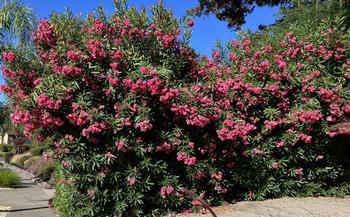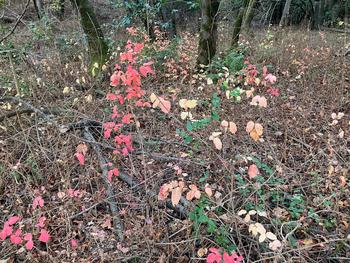Poisonous plants
-
Sara O’Keefe
-
When my husband told me he saw a woman picking a bouquet of oleander, I was surprised that someone was unaware of oleander’s toxicity.
 In all candor, do not eat the oleander. Photo caption: Sara O'Keefe
In all candor, do not eat the oleander. Photo caption: Sara O'KeefeNerium oleander contains a potent heart toxin. The leaves and branches are dangerous if burned or used in cooking. It is among the most common calls to the California Poison Control System. Another frequent call concerns the death cap mushroom, Amanita phalloides, the deadliest of all mushrooms. Thousands of people are poisoned every year during the rainy season by misidentifying mushrooms. Victims taken to the hospital for treatment should take the mushroom to help identify the poison.
Different kinds of toxic plants cause gastrointestinal distress, like azaleas and rhododendrons, and some are deadly, such as poison hemlock, aconite/monkswood, castor bean seeds, and Nicotiana glauca. Other plants like poison oak and stinging nettle, a common herbal medicine that causes skin irritation when touched, may be irritating.
Plants have evolved toxic compounds as protection against predators and disease. That doesn’t mean you cannot plant them, but be aware of their toxicity to protect humans and pets. Poison oak in many colors. Photo: Sara O'Keefe
Poison oak in many colors. Photo: Sara O'Keefe
Some plants may have toxic or fatal parts yet have safe edible parts. The rhubarb leaves are poisonous, but the stalk is not; however, it is so sour most prefer it cooked with sugar in a pie. All parts of the American elderberry, Sambucus nigra, including the berries, are toxic unless cooked. For 2,000 years, Europeans thought tomatoes were fatal because they were classified in the nightshade family, Solanaceae. The plant contains toxic tropane alkaloids, but the fruit is edible, while the rest of the plant is toxic to the digestive system.The most common calls to the California Poison Control System are for these plants:
- Dumbcane, Dieffenbachia, is a toxic house plant. If chewed or bitten, it causes swelling that blocks the trachea, causing suffocation.
- Angel’s trumpets, Brugmansia species, are seriously toxic and hallucinogenic and used in herbal medicine.
- Poison oak, Toxicodendron diversilobum, with leaflets of 3 to 5 leaves, can be red, green, or white. It is a deciduous native.
- Stinging nettle Urticca dioica is a California native not considered a noxious weed or invasive and is used in herbal medicine.
- Poison hemlock and Conium maculatum are highly toxic to humans and animals when ingested. To keep from being poisoned by any of these plants, keep seeds, bulbs, and small fruits away from small children and teach them not to put plants into their mouths. Teach them to recognize poison oak and stinging nettle.
Do not eat or taste plants or their parts unless you are positive of identification, especially wild mushrooms. Avoid handling plants with milky sap, as some may be harmful. Euphorbias and Poinsettias may be harmful to pets. When pruning or otherwise handling these plants, wear gloves and eye protection to prevent a trip to the emergency room. Sago palm is toxic to humans and pets. Photo: Sara O'Keefe
Sago palm is toxic to humans and pets. Photo: Sara O'KeefeOne morning, we noticed our dog, Sunny, wobbling while standing. It was the rainy season, and the veterinarian’s assessment was that she had eaten a mushroom that had popped up overnight in our backyard. Happily, she survived.
When pets have access to plants, remember a dog’s ability to dig and jump and cats who like the view from high shelves. Fertilizers may only cause gastrointestinal irritation, but some are more toxic and can kill.
Some plants can poison pets if eaten: autumn crocus, cyclamen, kalanchoe, daffodils, and the true lilies can be fatal, while others are more benign. All parts of the sago palm are toxic to pets, but the berries are the most inviting to dogs. Cats are very sensitive to lilies.
Contact the California Poison Control System at https://calpoison.org for information, advice, and treatment.



